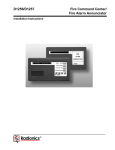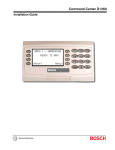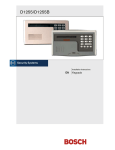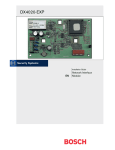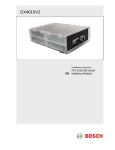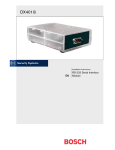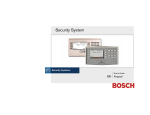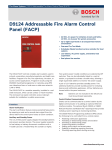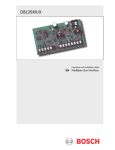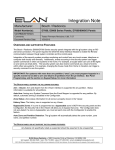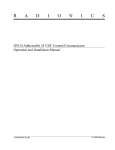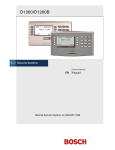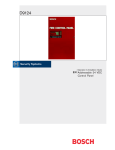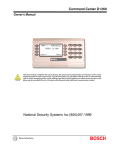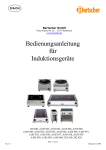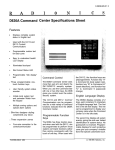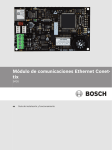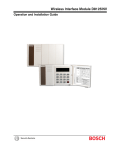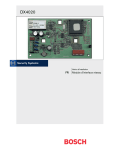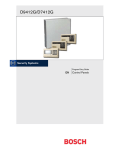Download Bosch D1257 Specifications
Transcript
Fire Command Center/Fire Alarm Annunciators D1256/D1257 Installation Instructions D1256/D1257 D1256/D1257 Installation Instructions 74-06925-000-H Page 2 © 2004 Bosch Security Systems D1256/D1257 Contents 1.0 1.1 1.2 1.2.1 1.3 2.0 3.0 3.1 3.1.1 3.1.2 3.2 3.2.1 3.2.2 3.2.3 4.0 4.1 4.1.1 4.2 4.3 4.3.1 4.3.2 4.3.3 4.3.3.1 4.3.3.2 4.3.3.3 4.3.3.4 4.3.4 4.3.4.1 4.3.4.2 4.3.5 4.3.5.1 4.3.6 4.3.6.1 Introduction.........................................................................................................................................................................................5 Before You Begin.................................................................................................................................................................5 Type Styles Used Here .......................................................................................................................................................5 Tips, Notes, Cautions and Warnings...............................................................................................................................5 Organization and Layout.....................................................................................................................................................5 Specifications.....................................................................................................................................................................................6 Overview ...............................................................................................................................................................................................7 D1256/D1257 Features.....................................................................................................................................................7 D1256.....................................................................................................................................................................................7 D1257.....................................................................................................................................................................................7 Description.............................................................................................................................................................................7 Display.....................................................................................................................................................................................7 Audible Tones .......................................................................................................................................................................7 Switch Settings.....................................................................................................................................................................8 Installation ...........................................................................................................................................................................................9 Mounting the D1256 and D1257 ....................................................................................................................................9 Mounting Locations .............................................................................................................................................................9 Wiring the D1256 and D1257..........................................................................................................................................9 Programming the Control Panel .................................................................................................................................... 10 Command Center Assignments..................................................................................................................................... 10 Area Text.............................................................................................................................................................................. 10 Custom Function ............................................................................................................................................................... 10 CF 128 – ALARM SILENCE ?....................................................................................................................................... 10 CF 129 – TROUBLE SILENCE ? ................................................................................................................................. 11 CF 130 – DETECTOR RESET ? .................................................................................................................................. 11 CF 131 – ANUNCIATOR RESET................................................................................................................................. 11 Menu/Function List ........................................................................................................................................................... 11 Menu Item and Function .................................................................................................................................................. 12 CC Address #.................................................................................................................................................................... 12 Passcode Worksheet....................................................................................................................................................... 12 Passcode............................................................................................................................................................................. 12 User Interface ..................................................................................................................................................................... 13 Command Center Functions .......................................................................................................................................... 15 D1256/D1257 Installation Instructions © 2004 Bosch Security Systems Page 3 74-06925-000-H D1256/D1257 Contents Figures Figure 1: D1256/D1257 Internal Arrangement............................................................................................................................7 Figure 2: Example 1 – Area Text ................................................................................................................................................... 10 Figure 3: Example 2 – Custom Function..................................................................................................................................... 10 Figure 4: Example 3 – Menu/Function List ................................................................................................................................. 11 Figure 5: Example 4 – Passcode Worksheet............................................................................................................................. 12 Figure 6: Example 5 – User Interface for D7212B1, D9112B1, and D9124 (using the D9112LTB) ........................ 13 Figure 7: Example 6 – User Interface for D7212, D7212G, D7412, D7412G, D9112, D9412, D9412G and D9124 (using the D9112LTB-EX or D9412GLTB) ........................................................................................................ 14 Tables Table 1: D1256/D1257 Installation Instructions Organization.................................................................................................5 Table 2: D1256/D1257 Specifications..........................................................................................................................................6 Table 3: Key to Figure 1 .....................................................................................................................................................................7 Table 4: Switch Address Settings ...................................................................................................................................................8 Table 5: Wiring Connections ............................................................................................................................................................9 Table 6: Menu/Function List Description .................................................................................................................................... 12 D1256/D1257 Installation Instructions 74-06925-000-H Page 4 © 2004 Bosch Security Systems D1256/D1257 Introduction 1.0 Introduction 1.1 Before You Begin Before installing the D1256 or D1257, you should be familiar with the Operation and Installation Guide and Program Entry Guide for the control panel you are using. When using the D1256 or D1257 with the D9112B1 Control Panel, the firmware must be Revision 2.1 or higher. 1.2 Type Styles Used Here We use special type styles to help you identify the objects described in this guide. Bold text usually indicates selections that you may use while programming your control panel. It can also indicate an important fact to be noted. Bold Italicized text represents a prompt when used in a description. Italicized text references you to another section of the guide, or to a different guide. We also use Italicized text to symbolize names for records that you will create. Courier Text shows what may be printed on the Display or internal printer. [CAPITALIZED TEXT] in brackets represents user input (keystrokes or buttons). Capitalization may also be used for emphasis. 1.2.1 Tips, Notes, Cautions and Warnings Throughout this document helpful tips and notes will be presented concerning the entire application and/or programming the unit. They will be set off as follows: Caution These caution the operator that physical damage to the program and/or equipment may occur. 1.3 Organization and Layout These installation instructions consist of three chapters and an appendix. Table 1 below provides a brief description of each section. Chapter 1 Introduction This is the chapter you are reading. Chapter 2 Overview Description of the different parts of the D1256 & D1257. Chapter 3 Installation Procedures on how to mount and wire the D1256 & D1257 plus procedures on programming the control panel. Table 1: D1256/D1257 Installation Instructions Organization D1256/D1257 Installation Instructions © 2004 Bosch Security Systems Page 5 74-06925-000-H D1256/D1257 Specifications 2.0 Specifications Power Nominal 12 VDC supplied by the control panel Current Required Idle: 104 mA Maximum: 206 mA, with annunciator lighted and warning tone on. Wiring 4-wire supplies Data In, Data Out, +12 VDC, and Common. Maximum data loop resistance is 10 Ω. Dimensions (H x W x D) Base (HxW): 11.6 cm x 20.7 cm (4.6 in. x 8.2 in.) Cover: 10.9 cm x 20.6 cm x 2.9 cm (4.3 in. x 8.12 in. x 0.8 in.) Color Fire engine red Display 16 character vacuum fluorescent display. Each character is a 14-segment unit. Soft blue color. Operating Temperature 0°C to +50°C (+32°F to +122°F) Relative Humidity 5% to 85% @ +30°C (86°F) Table 2: D1256/D1257 Specifications D1256/D1257 Installation Instructions 74-06925-000-H Page 6 © 2004 Bosch Security Systems D1256/D1257 Overview 3.0 Overview 3.1 D1256/D1257 Features The D1256 Fire Command Center and the D1257 Fire Alarm Annunicator are 4-wire serial devices used with the following Bosch Security Systems control panels: D7212B1 D9112B1 • • • D7212, D7212G • D7412, D7412G • D9112 • D9412, D9412G • D9124 (using the D9112LTB) • D9124 (using the D9112LTB-EX or D9412GLTB) Each control panel listed here supervises up to eight command centers/annunicators. You can connect a total of 32 command centers/annunicators to the system. The number of supervised command centers/annunicators, number of areas, and the available power affect the total number of command centers/annunicators you can connect to the system. 3.1.1 D1256 The D1256 provides annunciation as well as system control. Four function keys on the D1256 provide quick execution of alarm silencing, trouble silencing, annunciator display reset, and sensor reset functions. 3.1.2 D1257 The D1257 provides remote annunciation without system control capability. It is well suited for use in locations where the public may have access to it. Two keys on the D1257 allow the user to step forward or backward through a list of system events. 3.2 Description 1 Item 1 2 3 4 5 6 2 7 7 2 2 1 3 4 2 5 2 3 4 5 Description Vacuum florescent display Mounting hole Speaker for sounder Wiring harness connector Address DIP switches Speaker volume control (potentiometer) Keypad (arrangement is different for D1256 and D1257) 6 Table 3: Key to Figure 1 6 Figure 1: D1256/D1257 Internal Arrangement 3.2.1 Display Both the D1256 and D1257 use a 16-character English language display with custom programmable text. The custom text programmed at the control panel appears in the LED display (see #1, Figure 1). They display the latest status conditions of the fire system using words, numbers, and symbols. When an alarm occurs, it is displayed until the user acknowledges the event at a command center. When a series of events affecting the system occur, each event displays in order of its priority. 3.2.2 Audible Tones Both the D1256 and D1257 have a built-in speaker that produces several distinct warning tones. The speaker volume can be changed by adjusting the potentiometer (see Figure 1). Turn the potentiometer clockwise to increase and counterclockwise to decrease the volume. You cannot connect external annunciation devices to the annunciators. D1256/D1257 Installation Instructions © 2004 Bosch Security Systems Page 7 74-06925-000-H D1256/D1257 Overview The following signals are silenced by pressing the appropriate key at the D1256 Fire Command Center. • Fire Signal – When the system is in alarm, the annunciators emit a pulsed, high pitched "bell" tone. • Invalid Key Buzz – When an invalid key, or sequence of keys, is pressed, the annunciators emit a flat buzz tone. • Keypad Encoding Tone – Emits a muted beep tone as each key is pressed to indicate that the entry has been accepted. To disable this feature, see Section 3.2.3 Switch Settings. • Trouble Buzzer – When a trouble event occurs, such as a service alert, the annunciators emit a two tone warble until you press the [TROUBLE SILENCE] key on the D1256. 3.2.3 Switch Settings A 6-position switch located under the D1256 and D1257 cover allows you to select the address of each annunciator and silence the keypad encoding tones (see Figure 1). To access the switches: 1. Remove the front cover. 2. a. Using a small flat-bladed screwdriver, gently push in the two bottom tabs of the enclosure cover. b. While pushing the tabs in, lift the cover away from the base. Set the switches as follows: Switch 1 2 3 4 Address #1 ON ON ON ON Address #2 OFF ON ON ON Address #3 ON OFF ON ON Address #4 OFF OFF ON ON Address #5 ON ON OFF ON Address #6 OFF ON OFF ON Address #7 ON OFF OFF ON Address #8 OFF OFF OFF ON 5 ENCODING TONE ON/OFF Address # 6 ON ON ON ON ON ON ON ON Table 4: Switch Address Settings D1256/D1257 Installation Instructions 74-06925-000-H Page 8 © 2004 Bosch Security Systems D1256/D1257 Installation 4.0 Installation 4.1 Mounting the D1256 and D1257 The D1256 and D1257 are low profile, surface-mounted units molded in durable red plastic. They can be mounted using the following optional packages: • D56 Command Center Keypad Conduit Box (protected surface or flush mount) • D54B Command Center Flushmount Kit (brass) • D54C Command Center Flushmount Kit (stainless steel) 4.1.1 Mounting Locations Do not mount annunciators in a location where they are exposed to direct sunlight. Direct sunlight can interfere with the display screen's visibility and damage internal components. Do not mount the annunciators in wet or moist locations. 4.2 Wiring the D1256 and D1257 A four-wire flying lead (see Wiring harness connector in Figure 1) is required for the data and power connections between the annunciators and the control panel. The annunciators come with a wiring harness consisting of four color-coded flying leads with a female four-pin connector plug at one end. To wire the D1256 and D1257: 1. Power down the control panel. 2. Connect the flying leads of the wiring harness (provided) to the wiring terminals on the panel. D1256/D1257 Harness Connecting to a compatible control panel (see Section 3.1 D1256/D1257 Features) Connecting an additional annunciator to the D9100 Carrier Module (a component within the D9124) 12 VDC (red) to Terminal 32 12 VDC (Terminal 1) Data In (yellow) to Terminal 31 Data Out (Terminal 3) Data Out (green) to Terminal 30 Data In (Terminal 4) COMMON (black) to Terminal 29 COMMON (Terminal 2) Table 5: Wiring Connections 3. 4. 5. 6. 7. 8. Follow the procedures in Section 3.2.3 Switch Settings. Turn the command center over and plug in the wiring connector through the opening in the back of the enclosure base. Mount the annunciator's base to the wall. Secure it in place using the three mounting holes inside the enclosure base. Replace the cover. Align and insert the top two tabs of the enclosure cover into the top two tab slots of the enclosure base. Hold the top edges of the enclosure cover and base in position. While pushing the tabs inward, press the enclosure and cover down until the cover snaps into place. D1256/D1257 Installation Instructions © 2004 Bosch Security Systems Page 9 74-06925-000-H D1256/D1257 Installation 4.3 Programming the Control Panel The Command Center, User Interface, Command Menu (D7212B1, D9112B1, and D9124 (using the D9112LTB)) or Function List (D7212, D7212G, D7412, D7412G, D9112, D9412, D9412G and D9124 (using the D9112LTB-EX or D9412GLTB)), and Passcode Worksheet sections of the control panel program determine the annunciator displays and functions available from the D1256. Key points to consider are described in the remainder of this section. 4.3.1 Command Center Assignments 1. Command Center Text. The D1256 can be used on any one of the eight addresses in the control panel. Sections 4.3.2 through 4.3.4.2 describe programming for one D1256 assigned to Command Center #1. 2. Supervised. Certain local jurisdictions may require that fire system annunciators be supervised. If this is a requirement in your area, set supervision to YES for the addresses that use fire alarm annunciators. 3. Scope. The D1256 is designed to acknowledge fire alarms and troubles, not burglar alarms and troubles. Set the scope to include fire areas only. 4. Area. Program the area number of the fire area(s) as normal. 4.3.2 Area Text Area 1 P R E C H E * F I P R E Area # is On Area # Not Ready Area # is Off Area # Acct is On S C R S S K E S A F S A L I Y L A R S A Area 2 _ _ _ _ _ _ _ _ _ _ _ _ R M S I L E S Y S T E M * R M S I L _ _ _ _ _ _ _ _ _ _ _ _ _ _ _ _ _ _ _ _ _ _ _ _ _ _ _ _ _ _ _ _ _ _ _ _ _ _ _ _ _ _ _ _ _ _ _ _ _ _ _ _ Figure 2: Example 1 – Area Text 1. 2. 3. 4. Area # is On – PRESS ALARM SIL. Fire area should remain in the OFF state at all times. If the authority level is not programmed correctly, the fire alarm area arms and PRESS ALARM SIL displays on the fire alarm annunciator. Pressing the [ALARM SILENCE] key will both silence any alarm(s) and disarm the area. This causes the fire alarm annunciator to show the normal * FIRE SYSTEM * display. Area # Not Ready – CHECK FIRE SYS. Most fire alarm areas consist of all 24-hour points and the Area # Not Ready display is not used. If a controlled point type is used for some type of fire supervision device, and the device becomes off-normal, CHECK FIRE SYS displays on the fire command center. Area # is Off - * FIRE SYSTEM *. This is the normal idle text for the fire alarm annunciator. Area # Acct is On - PRESS ALARM SIL. Fire area should remain in the OFF state at all times. If the authority level is not programmed correctly, the fire alarm area arms and PRESS ALARM SIL displays on the fire alarm annunciator. Pressing the [ALARM SILENCE] key silences any alarm(s) and disarms the area. This causes the fire alarm annunciator to show the normal * FIRE SYSTEM * display. 4.3.3 Custom Function CF 128 CF 129 CF 130 CF 131 Text A L T R D E A N A O T U R U E N M S I L E N C E ? B L E S I L E N C E ? C T O R R E S E T ? C I A T O R R E S E T 1 A A 1 2 4 4 2 5 C 7 5 6 C _ 6 0 _ _ 0 0 _ _ 0 E _ _ C _ _ _ _ _ _ _ _ _ _ _ _ _ _ _ _ _ _ _ _ _ _ _ _ _ _ _ _ _ _ _ _ _ _ _ _ Figure 3: Example 2 – Custom Function These items must be programmed as indicated in the Custom Functions section of Command Center to make the D1256 function keys operational. The passcode 125600 has been chosen for the following examples, although any passcode may be used. 4.3.3.1 CF 128 – ALARM SILENCE ? Key Stroke: [1][2][5][6][0][0][E]. This custom function is programmed as the first Menu item. It is executed when the [ALARM SILENCE] key is pressed on the D1256. The key stroke entry of 125600E is seen by the control panel as a valid passcode entry in the area having the authority level to silence a ringing fire bell in the area. The "E" at the end of the string represents the [ENTER] key on the command center. D1256/D1257 Installation Instructions 74-06925-000-H Page 10 © 2004 Bosch Security Systems D1256/D1257 Installation 4.3.3.2 CF 129 – TROUBLE SILENCE ? Key Stroke: [A][4][C]. This custom function is programmed as the second item in the Menu and is executed whenever the [TROUBLE SILENCE] key is pressed on the D1256. This entry is equivalent to the execution of a [COMMAND][4] at the D1256. 4.3.3.3 CF 130 – DETECTOR RESET ? Key Stroke: [A][4][7]. This custom function is programmed as the third Menu item and is executed when the [DETECTOR RESET] key is pressed on the D1256. This entry is equivalent to the execution of a [COMMAND][47] at the D1256. 4.3.3.4 CF 131 – ANUNCIATOR RESET Key Stroke: [1][2][5][6][0][0][C]. This custom function is programmed as the fourth command menu item and is executed when the [ANNUNCIATOR RESET] key is pressed. Execution of this function clears the "View Memory" buffer, but does not clear the event out of the event log contained with the control panel. 4.3.4 Menu/Function List Menu/Function List Menu Item 1 2 3 4 5 6 7 8 9 10 11 Function 128 129 130 131 __9 _10 _12 _21 _29 _32 ___ CC Address 1 Yes / No Yes / No Yes / No Yes / No Yes / No Yes / No Yes / No Yes / No Yes / No Yes / No Yes / No CC Address 2 Yes / No Yes / No Yes / No Yes / No Yes / No Yes / No Yes / No Yes / No Yes / No Yes / No Yes / No CC Address 3 Yes / No Yes / No Yes / No Yes / No Yes / No Yes / No Yes / No Yes / No Yes / No Yes / No Yes / No CC Address 4 Yes / No Yes / No Yes / No Yes / No Yes / No Yes / No Yes / No Yes / No Yes / No Yes / No Yes / No CC Address 5 Yes / No Yes / No Yes / No Yes / No Yes / No Yes / No Yes / No Yes / No Yes / No Yes / No Yes / No CC Address 6 Yes / No Yes / No Yes / No Yes / No Yes / No Yes / No Yes / No Yes / No Yes / No Yes / No Yes / No CC Address 7 Yes / No Yes / No Yes / No Yes / No Yes / No Yes / No Yes / No Yes / No Yes / No Yes / No Yes / No CC Address 8 Yes / No Yes / No Yes / No Yes / No Yes / No Yes / No Yes / No Yes / No Yes / No Yes / No Yes / No Figure 4: Example 3 – Menu/Function List In the control panel’s Program Record Sheet, this section is referenced as the Menu List [for Control Panels D7212B1, D9112B1 and D9124 (using the D9112LTB)] and as the Function List [for Control Panels D7212, D7212G, D7412, D7412G, D9112, D9412, D9412G, and D9124 (using the D9112LTB-EX or D9412GLTB)]. D1256/D1257 Installation Instructions © 2004 Bosch Security Systems Page 11 74-06925-000-H D1256/D1257 Installation 4.3.4.1 Menu Item and Function Bosch Security Systems recommends programming the first ten menu items as indicated in Table 6. The first four menu items must be programmed as indicated in Table 6 for the D1256 to function properly. The first four keys on the D1256 annunciator execute the first four menu items turned on at the command center address. Menu items five through ten are optional features that can be programmed into the D1256 system. See the Fire System User's Guide (P/N: 71-06991-000) for further explanation of these optional programmable items. Note: Please make sure that CF 128 to 131 and any other functions that you are using in the menu are programmed E (Enabled) not P (Passcode Required). Menu Item Function Description 1 128 ALARM SILENCE? 2 129 TROUBLE SILENCE? 3 130 DETECTOR RESET? 4 131 ANUNCIATOR RESET 5 9 VIEW MEMORY? 6 10 VIEW PT STATUS? 7 12 FIRE TEST? 8 21 VIEW LOG? 9 29 REMOTE PROGRAM? 10 32 DISPLAY REV? Table 6: Menu/Function List Description 4.3.4.2 CC Address # Program command center addresses to YES for the first four menu items and the optionally program menu items five through ten as YES. 4.3.5 Passcode Worksheet Passcode Worksheet User Flag 000 001 User 00 01 Passcode ______ 125600 User Window __ __ 1 15 14 2 15 __ 4 15 __ Area Auth 5 6 15 15 __ __ 7 15 __ 8 15 __ User Name __________________________________ __________________________________ Figure 5: Example 4 – Passcode Worksheet 4.3.5.1 Passcode A special passcode must be programmed as a valid passcode for the system to work. This passcode is used in Custom Functions 128 and 131. Any user number can be used to establish this mandatory valid passcode. It must additionally be created as a valid passcode in the area to which the D1256 is assigned. Bosch Security Systems recommends using authority level 14 in conjunction with the passcode you choose (see Authority Level Selections). D1256/D1257 Installation Instructions 74-06925-000-H Page 12 © 2004 Bosch Security Systems D1256/D1257 Installation 4.3.6 User Interface Cmd Center Function Authority Level Selections Blank = Disabled / E = Enabled Blank = Disabled / E = Enabled / P = Passcode # 1 2 3 4 5 6 7 8 9 10 11 12 13 14 15 16 17 18 19 20 21 22 23 24 25 26 27 28 29 30 31 32 33 34 35 Function Disarm Master Arm Mstr Arm Inst Perim Inst Perim Delay Watch Mode Perim Partial View Area Stat View Event Mem View Pt Status Walk Test Fire Test Send Report Not Used Chg Display Chg Time/Date Chg Passcode Add Passcode Del Passcode Extend Close View Log Print Log User Cmd 7 User Cmd 9 Bypass a Pt Unbypas a Pt Reset Sensors Relay Control Remote Program Move to Area Not Used Display Rev Service Walk Default Text Change Skeds Force Arm Area O/C Restricted O/C Perimeter O/C Send Duress Passcode Arm Passcode Disarm Command 1 2 3 4 5 6 7 8 9 10 11 12 13 14 CMD 1 CMD 11 CMD 2 CMD 3 CMD 6 CMD 8 CMD 40 CMD 44 CMD 58 CMD 41/42 CMD 49 CMD 45 CMD 55 CMD 56 CMD 53 CMD 51 CMD 7 CMD 9 CMD 0 CMD 00 CMD 47 CMD 54 CMD 43 CMD 50 CMD 59 15 E/P P E E E E E E E E E E E E E E E E E E E E E E E E E E E E E E E E CMD 57 CMD 52 P P P P P P P E Figure 6: Example 5 – User Interface for D7212B1, D9112B1, and D9124 (using the D9112LTB) D1256/D1257 Installation Instructions © 2004 Bosch Security Systems Page 13 74-06925-000-H D1256/D1257 Installation Figure 7: Example 6 – User Interface for D7212, D7212G, D7412, D7412G, D9112, D9412, D9412G and D9124 (using the D9112LTB-EX or D9412GLTB) Note: Please make sure that CF 128 to 131 and any other functions that you are using in the menu are programmed E (Enabled) not P (Passcode Required). D1256/D1257 Installation Instructions 74-06925-000-H Page 14 © 2004 Bosch Security Systems D1256/D1257 Installation Figure 7 (cont’d): Example 6 – User Interface for D7212, D7212G, D7412, D7412G, D9112, D9412, D9412G and D9124 (using the D9112LTB-EX or D9412GLTB) 4.3.6.1 Command Center Functions The following command center function must be turned on to enable the [DETECTOR RESET] key. • #27 Reset Sensors It is suggested that the items below be included in the menu. • #9 View Event Memory • #10 View Point Status • #12 Fire Test • #21 View Log • #29 Remote Program • #32 Display Rev D1256/D1257 Installation Instructions © 2004 Bosch Security Systems Page 15 74-06925-000-H D1256/D1257 Installation Further customization can be required if the D1256 is connected to a D7212B1, D9112B1, or D9124 (using the D9112LTB) is located in an unsecured area, and/or if D1255 Command Centers are installed in the same system. The factory loaded program for the D9124 makes these functions available without requiring a passcode entry. For example, the D1256 is connected to a D7212B1, D9112B1, or D9124 (using the D9112LTB) located in a secure area, but the D1255 Command Centers are also installed, restricting command center functions by requiring a passcode in Cmd Center Function is advisable. Note: For D7212B1, D9112B1, or D9124 (using the D9112LTB) Control Panels, it is important to program each of the command center functions with an E (Enabled) and not P (Passcode Required). If any of the command center functions are programmed with a P (Passcode Required), then that custom function must also be programmed to execute that menu item from the command center. This custom function must include the appropriate passcode to let the programmed function work properly. For example, if View Event Memory were to be passcode protected and the chosen passcode was 125600, the macro string would be [A][4][0][1][2][5][6][0][0][E]. Consideration should be given to passcode protecting the command center function in combined burglary/fire applications. Function numbers for standard User Interface command center functions can be programmed in the Menu Function List for D1256 and D1255 addresses. Remember to enable functions only as appropriate for the command center at the address. As the D1256 does not have numeric keys, it can not be used to access functions requiring a passcode. Note: For D7212, D7212G, D7412, D7412G, D9112, D9412, D9412G and D9124 (using the D9112LTB-EX or D9412GLTB) Control Panels, embedding passcodes inside Custom Functions is not allowed. Therefore, any command used in a Custom Function, should not be passcode protected. Please make sure that CF 128 to 131 and any other functions that you are using in the menu are programmed E (Enabled) not P (Passcode Required). © 2004 Bosch Security Systems 130 Perinton Parkway, Fairport, NY 14450-9199 USA Customer Service: (800) 289-0096; Technical Support: (888) 886-6189 74-06925-000-H Installation Instructions 12/04 D1256/D1257 Page 16 of 16
















